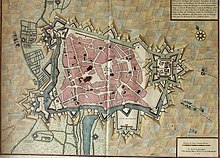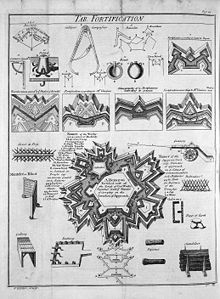Siege of Cambrai (1677)
This article includes a list of references, related reading, or external links, but its sources remain unclear because it lacks inline citations. (April 2013) |
| Siege of Cambrai | |||||||
|---|---|---|---|---|---|---|---|
| Part of the Franco-Dutch War | |||||||
 The Surrender of Cambrai | |||||||
| |||||||
| Belligerents | |||||||
| Kingdom of France | Spain | ||||||
| Commanders and leaders | |||||||
| Louis XIV | Dom Pedro de Zavala | ||||||
| Strength | |||||||
| 40 000 | 4 000 | ||||||
| Casualties and losses | |||||||
| 1,200 killed and wounded | 2,000 killed and wounded | ||||||


The Siege of Cambrai took place from 20 March to 19 April 1677 during the Franco-Dutch War.
Background
As a Principality dependent on the Holy Roman Empire and close to the border of the Kingdom of France, submitted to Spain since 1543, Cambrai was besieged several times by the kings of France (in 1477 by Louis XI of France and, between 1581 and 1595, by Henry III of France and Henry IV of France).
Sully and Richelieu had established a national policy of "putting [France] in its first strength and its former splendor", and "put France in all places where was ancient Gaul", which included Artois, Hainaut and the provinces of the Netherlands. During the reign of Louis XIV, Cambrai was besieged unsuccessfully by the French in 1649 and again in 1657.
In 1667, Louis XIV, invoking the right of devolution to justify the claims of his wife Maria Theresa of Spain on several Spanish provinces, address to the Regent of Spain, Marie-Anne of Austria, a "Treaty on the rights of the most Christian Queen on various states of the monarchy of Spain " and then without waiting for an answer commenced hostilities in May. During the summer of 1667 the French took Charleroi, Tournai, Douai and Lille and in February 1668 the Franche-Comté. By the Treaty of Aix-la-Chapelle (1668) Spain abandoned the cities of Charleroi, Binche, Ath, Douai, Tournai, Oudenarde, Lille, Armentieres, Courtrai, Bergues and Furnes.
These achievements marked a significant advance but did not establish a defensible border: two prominent areas remained Spanish, between St. Omer and Ypres on the one hand and between Cambrai and Valenciennes on the other. Cambrai was in effect a peninsula tied to the Spanish Netherlands by Bouchain and Valenciennes sandwiched between Arras to the west and Le Quesnoy and Landrecies to the east (French since the Treaty of the Pyrenees in 1659). In 1673 Vauban advocated in a letter to Louvois a defensive military doctrine known as the "backyard of the King" which called for a straighter border: "Therefore, whether by treaty or by a good war, Monsignor , always preach the quadrature, not of the circle, but of the backyard. It is a beautiful and good thing to be able to hold owns ground with two hands. "
In 1672, hostilities resumed against the Republic of the Protestant Netherlands. With a professional army well paid and well organized which includes more than 279,000 men, boasting a powerful artillery, the French monarchy was then the best army in Europe. Facing it, the strongholds of the Spanish Netherlands were defended by a few thousand men, often poorly paid mercenaries, and bourgeois companies offering little more than their courage.
In spring 1676 Bouchain and Condé-sur-l'Escaut were occupied by the French and Valenciennes was stormed on 17 March 1677. Louis XIV, "ensuring forever the rest of his borders", decided to take Cambrai and attended in person the siege of the city, while his brother Philippe I, Duke of Orléans besieged Saint-Omer.
Conditions of the siege
The reputation of the place of Cambrai was great. Boileau wrote in its praise:
"Cambray and St. Omer were the two strongest strongholds which the Spaniards had to defend. These cities, both situated on the borders of France, served as advanced positions and enabled them to make the law in the midst of their triumphs: Cambray was especially formidable. The Kings of Spain considered this Place more important than all the rest of Flanders together. She was famous for the number of indignities she had inflicted upon the French. "
Spain's King Charles II of Spain considered this place as a point of resistance to flank the French territories and, according to Boileau, France judged that the Spaniards would save no efforts to hold St. Omer and Cambrai, whose loss was likely to lead to the loss of the rest of the Netherlands.
The defense of the city is supported by inundating the river Scheldt to the south and the west, and by the citadel, built in 1543 on the orders of Charles V, to the north-east. The cold weather, rain and snow, makes the conditions even more difficult for the besiegers.
On the other hand, Cambrai is isolated and can not expect any help. The Governor Don Pedro de Zavala, according to Paul Pellisson, "is old and broken, and as they say, often dizzy". The Garrison is "mainly Spanish, but believed to have forgotten the art of war". The Citadel, " is small despite its reputation, and will be thunderstruck by lightening bombs and cannon fire as soon as it will have been approached. "
The secret services of Louvois informed him of the feelings of the citizens of Cambrai: "they are not aggressive and have no particular ties with Spain. Furthermore, the rapid capture of Valenciennes does not encourage them to resist France".
The Siege
On 22 March the King, with the Marshal de la Feuillade, moved to Awoingt from where he directs the siege of the city. Marshal Luxembourg takes up position at Marlière, Marshal the Lorges at Escaudœuvres, and Marshal Schomberg at Ramillies. In the company of the King are also ministers Louvois and Pomponne and Father de la Chaise, his confessor.
The French army is composed of 38 infantry battalions and 48 cavalry squadrons, in total more than 40,000 men. The Spanish have only some 4,000 to defend Cambrai.
Vauban, in control of the operations, began constructing lines of circumvallation and contravallation surrounding the city. The isolated town can not hope to be relieved. Its northern front remains vulnerable. Taking advantage of this weakness, the French opened a trench near the Notre Dame gate. With the help of 7,000 farmers from Picardy work progressed rapidly, despite the extreme cold and rainy weather. Mounds are built to place, for a better performance, the guns at the same level as the Counterscarp.
On 30 March the first batteries begin to pound the three ravelins and the body of the gate.
On 1 April French troops attacked the three ravelins.
On 2 April French troops invested the ravelin between the Selles and Notre Dame gates.
On 5 April the Spanish abandoned the city, after that the French troops had undermined the fortifications, and the garrison took refuge in the citadel. The French then open a trench on the esplanade.
During the night of 11-12 April, 150 French soldiers were killed.
In response, the King has the fortifications at the bastion of St. Charles undermined at three locations. The governor, however, refuses to surrender.
On 17 April, after the French command threatened to explode two other mines that would make the fortifications collapse, the governor Dom Pedro de Zavala, injured on the leg during the fighting, surrendered. The king heard the news while attending mass with Father de la Chaise in Awoingt.
On 19 April 1677, after the usual negotiations, the Spanish governor Dom Pedro de Zavala, on a stretcher because of his injury, hands over the keys of the citadel to the King. After a siege of 29 days, Vauban honoured his enemy for his gallant defense, and let the 2,000 still valid Spaniards leave the place "drums beating, matches lighted, with colors flying." The French had lost more than 1,200 injured or killed.
On 20 April Louis XIV entered the city and had a Deum sung in the Old Cambrai Cathedral. He also visited the citadel, and found it not as strong as he had thought.
On 21 April the King of France named the Marquis de Cezen governor of the city. the Marquis appointed 14 new aldermen, but kept the previous provost.
The following day the king left Cambrai for Douai.
The conquest of Cambrai increased the King's glory, because of the antiquity of the city and the prestige of his archbishopric. It was illustrated by numerous sketches, etchings and drawings, by artists like Adam Frans van der Meulen and Nicolas Boileau, who wrote:
"Cambrai, for the French a dreadful pitfall
finally saw falling her ruins and her pride. "
By the Treaty of Nijmegen, signed on 10 August 1678, Cambrai is definitely attached to the Kingdom of France.
Bibliography
- Françoise Magny, Cambrai ville fortifiée, Cambrai, Maison Falleur, 1991. On trouve dans cet ouvrage le plan d'attaque français.
- Louis Trenard (dir.) et Michel Rouche (préf. Jacques Legendre), Histoire de Cambrai, Presses Universitaires de Lille, coll. « Histoire des villes du Nord / Pas-de-Calais », 1982, 24 cm, 314 p. (OCLC 10075612) Ouvrage utilisé pour la rédaction de l'article
- Jean-Pierre Wytteman (dir.) (préf. Bernard Derosier), Le Nord : de la Préhistoire à nos jours, Bordessoules, coll. « L'histoire par les documents », 1988, 381 p. (ISBN 2-903504-28-8) Ouvrage utilisé pour la rédaction de l'article
- Pierre Pierrard, Histoire du Nord : Flandre, Artois, Hainaut, Picardie, Hachette, 1er novembre 1978 (ISBN 2-01-020306-2) Ouvrage utilisé pour la rédaction de l'article
- Bernard Pujo, Vauban, Albin Michel, 1991 (ISBN 978-2226052506) Ouvrage utilisé pour la rédaction de l'article Histoire de France sous le règne de Louis XIV, tome 2, 1734, par M de Larrey
- Eugène Bouly, Histoire de Cambrai et du Cambrésis, t. 2, Cambrai, Hattu, Libraire-Éditeur, 1842 (1re éd. 1842) [lire en ligne (page consultée le 9 janvier 2011)]
- Jean Racine et Nicolas Boileau, Éloge historique du roi Louis XIV : sur ses conquêtes, depuis l'année 1672 jusqu'en 1678, Paris, Bleuet, libraire, 1784 [lire en ligne] Ouvrage utilisé pour la rédaction de l'article [PDF] Louis XIV dans les collections du musée de Cambrai sur musée de Cambrai. Consulté le 8 janvier 2011
